New to cooking with iron? Head over to our GETTING STARTED guide.
Find below a list of frequently asked seasoning-related questions. A common expectation is for naturally seasoned iron pans to be 'non stick', like we've become used to with synthetic coated non-stick pans. Whilst our iron pans come pre-seasoned, it is still a natural seasoning that will continue to build and develop with age and use. The key to a natural non-stick surface is good fat and heat management. Our pans are super conductive, so lower your heat! There can be a small adjustment period as you get used to cooking on iron, but it's so worth it. Your health, our planet and your food will thank you for it!
Seasoning is simply layers of oil that is baked onto the pan, through a process called polymerisation. Over time, this builds to form a natural, easy-release cooking surface that continues to get better with use. This ‘build-your-own’ seasoning is the only way to achieve a natural, non-toxic, non-stick surface that is forever renewable.
For AUS-ION™ Quenched finish seasoning instructions, CLICK HERE.
No initial 'at home' seasoning required for our Quenched finish, unless you desire a superior non-stick surface.
For AUS-ION™ RAW finish seasoning instructions, CLICK HERE.
For AUS-ION™ SATIN finish seasoning instructions, CLICK HERE.
An easy way to determine which finish you pan has is by the colour. Raw pans will be silver and coated in a light layer of beeswax, Satin pans are bronze and slightly rough to the touch. Quenched pans are a dark grey/black.
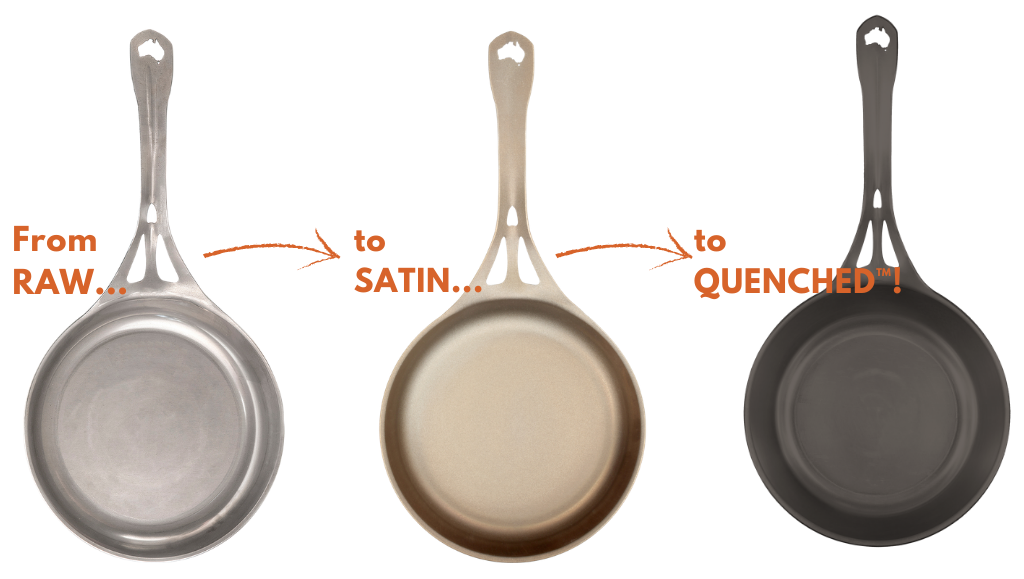
Building a low or non-stick surface can take time, and will continue to get better with appropriate care and continued use. It can take a little bit of getting used to but you'll soon develop your own flow. Don't expect the immediate slipperiness of synthetic non sticks. Seasoned iron is superior in every important way: health and sustainability and performance.
Seasoned iron will rarely look visually perfect on the cooking surface, and will continue to evolve and change depending on what, and how, you’re cooking. Don’t worry about how it looks – it’s all about performance! Whilst your seasoning is still young, cook with plenty of fats and oils, and lower your heat - our pans are so much more conductive than disposable 'non-stick' pans!
.png)
Did you know our pans get better with age?
Our pans are designed to be passed down through generations, so here is an image highlighting the difference between our wrought iron pans and what's normal with their aging process.
The graphic below shows how perfectly imperfect our iron pans look after four years and even eight years of cooking! It's very common for the look of your pan to change and develop as you cook.
.jpg)
A well-seasoned pan will be dark in colour, though often a bit patchy in reality. But don't worry about how your pan looks—what's important is how it cooks! It's best not to overthink it. Just cook, give it a touch-up seasoning if and when required, and let it be perfectly patchy!
We season our iron pans in-house (Quenched), so all you need to do is cook and season as required.
Currently we have a limited quantity of raw edition pans available—once they're gone, they’re gone!
Seasoning is not compulsory, though we do recommend it for all over corrosion protection, and to build your non-stick surface. Our AUS-ION™ Raw pans come coated in a light layer of non-GMO rice bran oil. Some people choose to just let their seasoning build naturally through cooking with fats and oils, though if you're new to cooking with iron, we do recommend following our seasoning instructions for best results. How much or little seasoning you choose to do is completely up to you!
Simply put: Our Quenched™ finish takes away the need for at-home oven seasoning, as we've done the work for you. Your seasoning and the non-stick surface will continue to build and get better the more you cook! Seasoning and cooking will also keep rust at bay.
The detail: Rust and iron can go hand in hand in the right conditions, i.e. if the iron is left wet, idle or unprotected. Our iron pans are made from pure iron and through cooking and seasoning will get better with age and use. The Quenched finish means we've done the work for you and they don't require you to do any oven seasoning when you first get your iron pan - they have a good solid layer of seasoning ie a patina and a fairly developed non-stick surface (in the right conditions i.e. good heat and fat control), though if you want your pan super non-stick, more stovetop seasoning is recommended. If you're not completely sure what seasoning is, it's a traditional method used for thousands of years with iron cookware, this link will help
Our Quenched™ finish is real, natural seasoning. It is not a synthetic coating. It will change and develop as you cook! Like all-natural, seasoned iron pans, acidic foods can strip the seasoning, food can stick if it's turned too soon i.e. iron pans release the food, the heat is too high (our pans are highly conductive, mediums is the new high), or not enough fat used, or the pan isn't cleaned properly etc. It can take an adjustment if you're used to cooking on synthetic coated, disposable pans.
The beauty of seasoned iron is, it is, forever renewable. It's always an easy fix! For rust, here's our FAQ on how to remedy. You'll find a light scrub to remove it will work, followed by either cooking something in fat which will naturally season the pan, building on the seasoned finish or you can do some stovetop seasoning - there's a great video guide in this link. Just follow our stovetop seasoning instructions to build your seasoning back up quickly and keep cooking.
A well-seasoned pan is often patchy in reality. It's all about performance! Seasoning is forever renewable. If you get "stuck", the rest of our Seasoning FAQs below will help get you back on track.
We recommend rice bran oil for best results, though any cooking oil or fat with a high smoke point can work well, such as grapeseed oil, flaxseed oil, canola oil, lard etc. Olive oil is not good for seasoning due to its low smoke point.
You can use whatever oil you choose to cook with.
Flaky seasoning is an indication of a weak seasoning foundation. There are a number of factors that can cause this: too much oil used in the initial oven seasoning; pans not left in oven long enough (1.5-2 hours) and at the correct temp (250C); not allowing pans to cool between seasoning layers; cooking acidic foods or boiling liquids; scrubbing seasoning off after use or cleaning with detergents.
The beauty of seasoned iron is it’s forever renewable so can be easily remedied. First off, you'll want to give it a good scrub back to remove all the lumpy/flaky bits using steel wool/scourer/fine sandpaper - whatever does the trick. Don't worry about scrubbing the whole pan back - just focus on the flaking/lumpy bits.
Then, just follow up with a few quick stovetop seasons following the video instructions below, to build your seasoning back up.
Sticky seasoning is usually a sign of excess oil built up on your pan. To remedy this, place your pan upside down (ideally on the top rack) without any oil application and bake at 250 degrees Celcius for 90 minutes.
From there, continue with your seasoning, the video in this link is very helpful.
And remember, less is more when it comes to oil application!
It can take some time to build a non-stick surface through seasoning, but it is very achievable - as has been done by cooks all over the world for hundreds of years (it’s not something we invented). Iron is so much more conductive than synthetic, disposable pans so it can take a period of adjustment. Be patient - it’s worth it! Better performance, non-toxic, healthy and sustainable.
There are a number of variables which can affect your how your pan and seasoning is performing as outlined below, but it usually comes down to two key factors: heat control and fats.
Here are the most common reasons food may stick:
If you’ve had a thorough read through all of our instructions and are still struggling, please send us an email, explaining the issues you’re having, along with some photos, and we’d be happy to guide you through it: info@solidteknics.com
Don't worry if your pan doesn't look perfectly black and shiny. Whilst a shiny black patina is achievable through continued seasoning and maintenance, it's really not necessary! In reality, pans will often be patchy. Your seasoning will continue to change and evolve depending on what/how you cook. Don't worry about how they look, our pans are built for performance! Here's a photo of our founder Mark Henry's workhorse pans. They may not look 'pretty', but they still perform excellently!
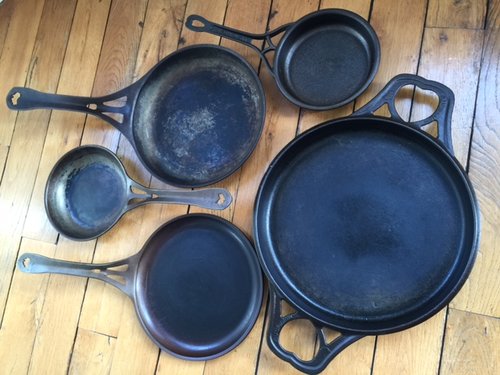
Iron rusts because of a chemical reaction known as oxidation. When iron is exposed to moisture or oxygen, oxidation occurs. In order to avoid rust, ensure your pan is well seasoned all over (through oven seasoning) and keep your pan dry when not in use.
Iron is susceptible to rust, especially if not sufficiently seasoned, has been left sitting unused for long periods of time (particularly in humid climates), or not dried properly after use. But don’t worry, it’s only superficial rust and easy to fix!
To remedy, simply scrub off the rust with a green scourer, scrubbing brush/steel wool/fine sandpaper. Follow up with further seasoning to ensure your pan has a good base to protect from corrosion, and make sure you dry your pan thoroughly after each use – ideally on a warm stovetop.
NB. We'd only suggest using baking soda or vinegar on very stubborn rust. If you believe your pan has stubborn rust. please refer to this blog on how to transform your pans back to their best cooking condition.
When we say forever renewable, we mean it.
Rough patches are carbonised food that acts like velcro to food. The surface must be smooth. Use a strong scraper to remove and smooth the surface, then follow up with a quick stovetop season per the video below or just continue cooking with fats and oils and let it build naturally.
There are a few things that can strip seasoning; most commonly the culprit is cooking acidic foods and/or liquid boiling - like tomatoes or tomato-based dishes, stews, curries, soups. Another culprit can be soaps or detergents.
We understand how disappointing it can be after all that hard work building it up, but the beauty of seasoned iron is it’s forever renewable! Some more stovetop seasoning and cooking with plenty of fats and oils, should have you back to where you were in no time.
Whilst it’s perfectly normal and fine to cook liquids and acidic foods in your AUS-ION pans, the best practice while the seasoning is young is to avoid them if you want to maintain your seasoning. If you’re wanting to cook crepes in the morning and curry in the evening, it’d be best to consider two pans - one with solid seasoning for all things nonstick, and the other for everyday curries, sauces etc. We recommend our nöni™ range for acidic foods and liquid boiling as it does not require seasoning.
For our best practice iron care instructions, click here.
Black specks are most often caused by food left on the pan, or weak seasoning, caused either by not cleaning thoroughly (you may occasionally need to give the pan a light scrub) or applying oil to your pan once dry (in between cooks - this can weaken your seasoning).
To remedy this, give your pan a good light scrub. This is not about removing seasoning, just the excess build-up. You can scrub with a scourer or even consider using salt and a splash of oil. The salt acts as an exfoliant. Rinse under hot water, and repeat if necessary. From there with a quick stovetop season per the video below or have a good cook up using fats/oils will form a clean solid smooth surface.
This is charred (greasy) food sticking to the seasoned oil.
Yes if you keep doing what you're doing (we recommend you change your process slightly).
Hot water alone won't perfectly remove burnt solids in grease, so hot water with no exfoliant can leave build-up on your pan.
After you finish cooking and while the pan is somewhat hot, put a heap of salt in the middle and with a paper-towel spread and lightly scrub the pan. The salt will pick up the would-be black stuff, largely disinfect the pan, and the abrasive properties of the salt help with the cleaning.
Wipe off the now brown salt from the pan, rinse under hot water if required and dry overheat and apply a coat of oil. The new coat will stick better through the salt's abrasive effect.
This routine may not eliminate the residue altogether. Though it works great long term and keeps the build-up of carbon at bay.
Our pans are made from a single, uniform sheet of iron, it's not possible for our one-piece pans to have hotspots. Hotspots can only be created by the heat source. To remedy this, we suggest heating your pan up on lower heat for longer, before adding fats/oils and commencing cooking. Heating lower for longer will allow the heat to distribute across the cooking surface.
What does vary greatly is the heat output of stovetops. For example, as induction can give out intense, almost instantaneous heat, it's really important to keep your heat low and slowly heat your pan - especially if your burner size is mismatched to the pan. Our pans are superconductive, so you'll find you never need to use more than medium heat.
Make sure the element is well matched to the size of the pan, as a small burner with a large pan will result in a concentration of heat in the centre. Always begin with low heat, to allow the pan time to heat slowly and disperse the heat, to achieve a more even heat. Matching the stovetop element to the pan can be difficult, you will find a helpful image HERE
The pan is overheating: If the heat is too high, the oil or fat in the pan will begin to smoke.
Residual food particles: If there are leftover food particles stuck to the pan, they may burn and cause smoking.
Using a low smoke point oil: Different oils have different smoking points, so using an oil with a lower smoke point can cause smoking. Choose a high smoke-point oil, such as rice bran oil. You can find a handy table summarising the smoke point of different cooking oils HERE.
Moisture in the pan: If the food you're cooking has a high water content, it can cause steam to form in the pan, which can result in smoking.
Insufficient oil: If there's not enough oil or fat in the pan, the food can stick and cause smoking.
Gas stovetop: If you're using a gas stovetop, it's possible that the flames are too high, cause the pan to overheat and smoke.
There is no hard and fast rule about how many times a pan should be seasoned. We recommend at least one oven seasoning for all over corrosion protection (if you have either one of our raw or satin pan, there is no need to oven season our Quenched pans, as we have already done this for you), followed by some stovetop seasoning to kick start your natural, non-toxic, low stick surface. Cook with plenty of fats and oils, and avoid acidic foods while your seasoning is young, and your seasoning will continue to build and improve the overtime.
Some ‘seasoned’ iron cooks choose not to season at all and just let it build up naturally through cooking. It’s really up to you!
Don't worry, it takes a lot more than a dishwasher to ruin our pans! Just follow our rust removal instructions above to bring your pan back to a cook-ready state. And remember, iron pans and wet/humid environments do not mix well. Simply clean with hot running water, and dry immediately.
Another way to avoid rust, is to ensure your pan is well seasoned all over (through oven seasoning). To learn all about seasoning read our handy seasoning guide.
Unlike synthetic coated pans, you don’t have to worry about scratching AUS-ION™. This means you can use any kind of cooking utensil in your AUS-ION™ pan (metal, woods, plastic, silicon). That said, we recommend taking the more sustainable route and opting for metal (this is also the most hygienic option).
Our kitchen tool range has no plastic or loose parts that can weaken or fail, meaning they're dependable and will cover all your kitchen tooling needs! Flexible and built to last: they're backed by our multi-century warranty, ensuring you get the best value for your money. Check out the range HERE.
There is no difference between our pans and all iron pans in terms of iron migration. They would all transfer similar amounts of iron under similar conditions. We’re not biochemists, but there have been quite detailed studies into the migration of iron from iron pans into food, and the effect is significant for bare iron with acidic foods, through to quite minimal for well-seasoned pans and fatty foods. We recommend further research for anyone who is in need of more iron or looking to avoid it.
Preheat: Before the food is placed in the pan, ensure it is preheated to the correct temperature (remember, you don’t need a high stovetop heat to get a hot iron pan, iron is very conductive). Many newcomers don't allow enough time for pan/oil to come up to heat, and this often causes sticking. After several generations of synthetic nonstick, most home cooks have been trained to use far too low a heat to properly sear meats, generally stewing the juices out at low temperature instead. Match your pan size to burner size as closely as possible. Avoid fast high power in small burners, especially induction, with pans of much larger base size: the concentration of heat in the centre can warp the pan unduly.
Meat: Meat tends to stick when the temperature of the pan is too low so a 'crust' is unable to form, and/or if meat is too cold (meat should always be brought to room temperature before frying). You don't need a high heat setting to get a hot pan. Choose a lower setting and wait a bit longer until you understand the relationship between your pan and the heat setting of your particular stovetop. Our pans can handle hot temperatures, though it's important to let the pan slowly preheat as exposing a cold pan to high, instant heat can cause thermal shock.
Don't attempt to move the meat too quickly - let it form a crust. Give it a little jiggle with tongs when you think it might be ready, and if it moves easily you can then lift it to check properly. If it's still stuck firm, don't move it! All this becomes much more intuitive with practice.
Do it like the chefs: quickly sear room temperature meat to seal and brown (at which point, the meat will naturally release from the pan when lifted), then transfer the pan to the oven to finish baking and retain the juices. A hot, well-seasoned pan doesn't need much oil, because it quickly caramelises and seals the surface. Coarse salt/pepper dry rub helps: see this YouTube video and this YouTube video.
Bacon: some bacon has a high sugar content and that's what causes gumming and sticking. Because iron cooking isn't so well known in Australia, there are lots of answers on USA forums and groups, and one of the good answers we recommend is can be found HERE.
Fish: Fish is delicate and tends to only require cooking over low heat on most stovetops. You will, however, need to get your pan hot first, heat it on medium and test its temperature by carefully moving your hand over the bottom of the pan. When you can feel it radiating heat, that’s a tell-tale sign it’s ready to cook in. Add your fat, and at this stage, you may want to turn your heat down, add your fish. Let your fish cook, and the skin crisp until the pan releases it. If it's sticking, it's not quite ready to flip.
As our pans are highly conductive, it comes down to good fat and heat control and a little trial and error to find your sweet spot as all stovetops vary, and disperse heat differently.
In summary:
Pat fillets dry with a paper towel. Season on both sides with salt and pepper.
Heat your pan over medium heat. When the pan is hot, add the oil/butter.
Lower heat and let sizzle until fish is golden and caramelised around edges, about 2 to 3 minutes.
Eggs: Conversely, eggs often stick when cooked at too high heat and/or for too long. Butter/oil should be used generously. Use a well-seasoned pan on low temperature for scrambled eggs and scrape around the whole pan gently toward the middle to avoid sticking and burning. See this video for the fail-safe scrambies formed-iron and cast-iron method.
The below video shows that, while it is usually best to cook proteins from room temp, not cold, both can cook just fine when the right heat and fat management is used:
Potatoes: If your seasoning is young, it might struggle to manage starch without adding more fat. Potatoes sticking is fairly normal on iron unless it is very well seasoned/cooked on, more fat is used and/or very little starch is present. We do also have to resist moving our food too quickly and just allow the food to form a crust that releases the food from the pan.
Give it the time it needs to develop a natural seasoned surface through plenty of cooking in fats or spend some time doing stovetop seasoning. Turn your heat down and increase your fats until you find the happy medium.
If you don't have a gas cooktop, it can be difficult to achieve uniform seasoning all over your wok, as there is only a small surface in direct contact with the heat source. We recommend at least four rounds of oven seasoning for corrosion protection. Stovetop seasoning will then help you build a non-stick surface on the base of your wok, but it's unlikely you'll achieve the same seasoning on the sides. But it's no big deal! In reality, pans are often patchy - this will not affect their performance. Just get cooking! Use plenty of fats/oils, and let it build naturally as has been done for thousands of years. Ensure you dry your wok thoroughly after washing and if you do encounter any surface rust from time to time, just give it a scrub to remove and re-season in the oven or simply cook a meal with plenty of fats/oils!
It's best not to overthink it, and don't worry about how they look. Just cook, and give it a touch-up seasoning if/when required. Here's a photo of one of our team member's woks - perfectly patchy!
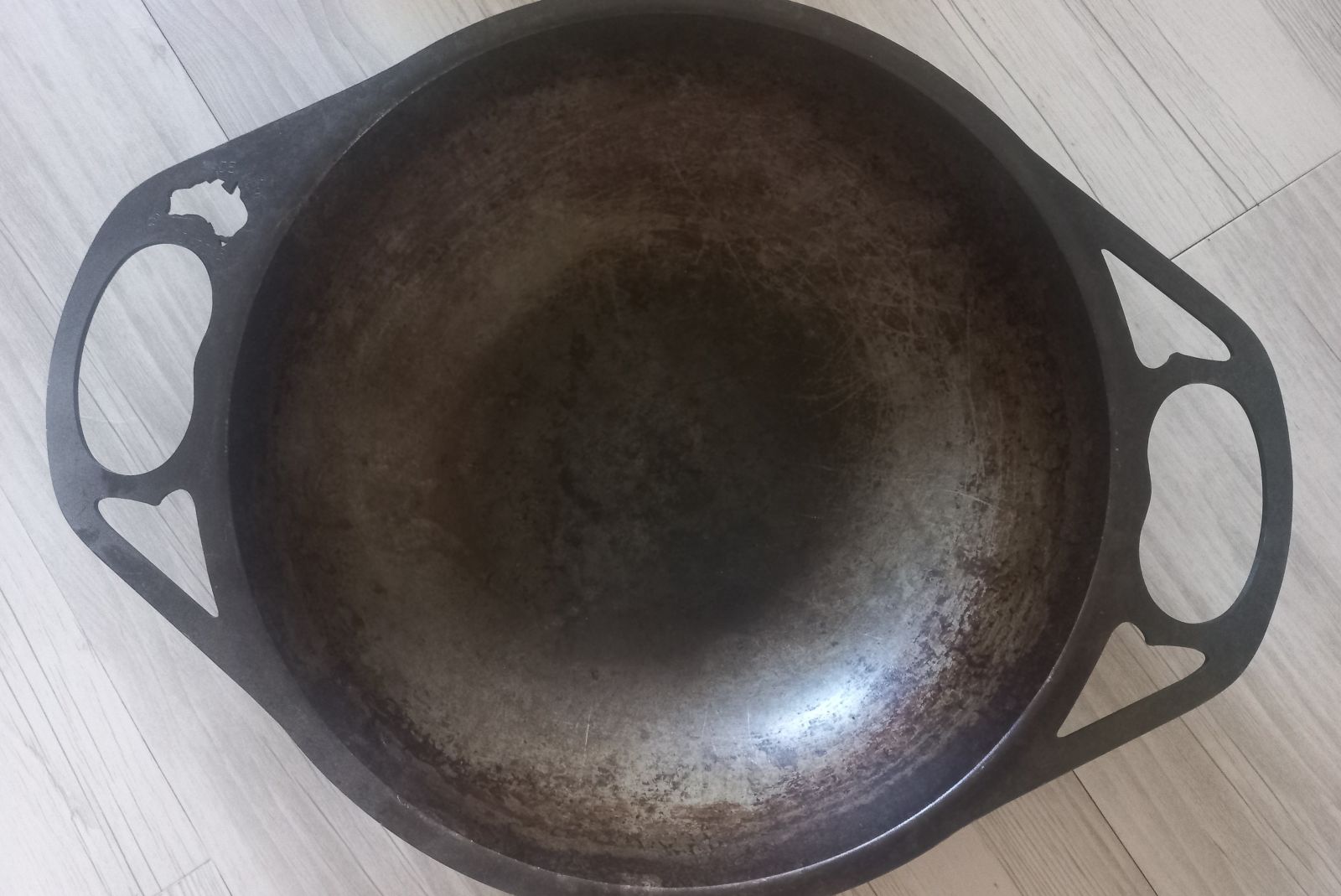
Our pans are designed to fit in standard 600mm ovens, however, internal dimensions of ovens can vary significantly between brands. Our full product dimensions and specifications are provided in our product listings, and we always recommend measuring your oven first. In saying that, there is a handy trick! Try spinning your pan around, so the handle is facing a back corner. This often creates enough space to enable you to shut the oven door.
As for oven seasoning, the pan does not need to sit flat. If needed, it can be propped up against a side in order to make it fit. The most important thing is that the pan is upside down.
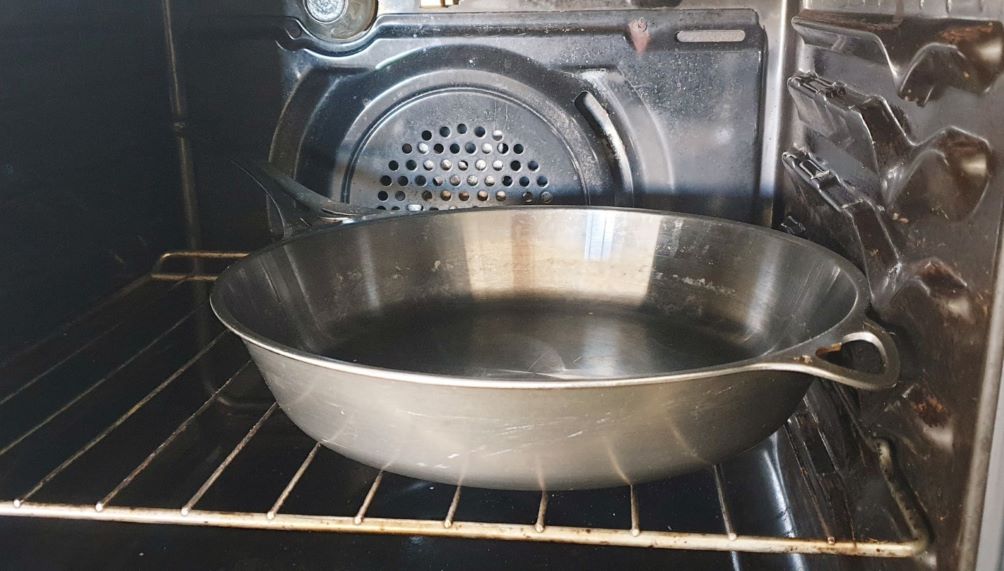
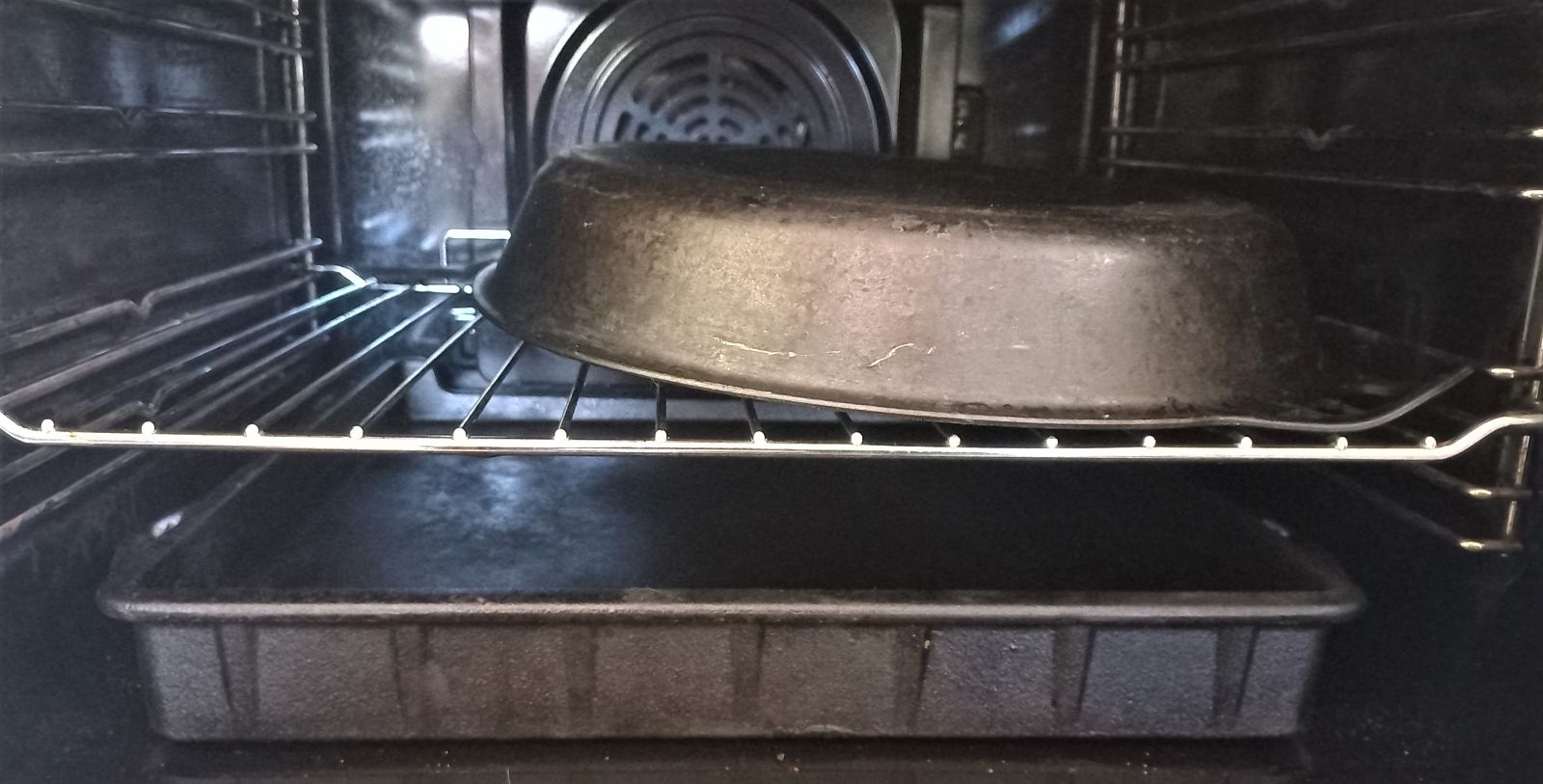
Our noni 31cm Sauteuse in a standard 600mm oven, and 30cm AUS-ION upside down for seasoning. The oven door will not shut if the handle is sticking outwards, though spin it around so the handle is in the back corner and it fits perfectly!
You can deodourise your pan by either heating your empty pan over low to medium heat on the stovetop for 15 minutes, or heating in a 250°C oven for 10 minutes.
Both methods will work equally well at eliminating odours. The oven method is fast and doesn’t add an undesired smell to your kitchen if your fish odour is particularly strong.
Alternatively, the below methods also work. The oven and stovetop heating methods above will not erode your seasoning whereas the below methods may:
Yes, with a mindful approach! Our Roasting Pan, Baking Trays and Baking Sheets can be used on the stovetop with care. If you have just pulled your Roasting Pan, Baking Tray or Sheet out of the hot oven and want to deglaze the pan to make a sauce or gravy on the stove, this will likely be okay as the metal is already hot and evenly expanded – so long as you use a low heat and your biggest element. However, if you are putting a cold Roasting Pan or tray on a hot stovetop (particularly where the element is small), it could result in uneven movement in the base. If you have a large element option on your stove and pre-heat on a very low setting, you may find it's okay. Please note, warping is not covered under our warranty.
The heat on a stovetop is concentrated to the shape and size of the element, and often contains hot spots. An oven, on the other hand, doesn't have this problem. In an oven cooking environment (which also includes over the fire and in a BBQ or pizza oven), the heat is evenly applied to the Roasting Pan or tray from all angles, which allows the entire pan to heat up and the metal to expand at an even rate.
When cooking on a stovetop, the heat is concentrated to the base of the pan. We always recommend appropriately matching the size of your burner, to the size of your pan, to ensure even heating. If the element is smaller than the pan's base (which would often be the case with our Roasting Pans given their large base), and care isn't taken to heat the pan slowly to allow the steel to expand and the heat to disperse, it could cause uneven movement in the base. This is why we've generally steered away from recommending them for stovetop use. However, if you have a large enough element and take care to heat slowly, then it's unlikely to be an issue.
With all that said, it's your pan - use it how it best serves you. Just keep the above in mind. ❤️
Oven burn risk: Take care when handling any hot metal pan, especially when taken from the oven, and use oven mitts to protect your hands and trivets to protect surfaces. After removing from an oven we recommend leaving the heat sock, mitt or towel over the handle to remind yourself the handle may still be hot.
Stove burn risk: our longer skillet handles are designed to resist heat transfer up the handle, and this works so successfully that hand heat protection is normally not required. This of course does not apply to ovens, or when the handle exposed to direct heat from underneath (such as over a campfire/coals or burner). The effective 'cool handle' effect does not work for other pan models with short handles, such as the AUSfonte cast iron BIGskillet and DEEPan, or the AUS-ION 30cm duel-handled wok, although their handle designs are better than most short loop handles.
Thermal shock: warping and cracking: Beware that iron pans can be warped and cast iron has been known to crack (although we’ve never seen it in AUSfonte) due to thermal shock from heating too quickly on electric or induction cooktops set on max. Warm your pan slowly on a lower heat before increasing to higher heats. This is particularly important with induction - please read 'Induction warping' below.
Thermal shock from cooling too quickly: never expose a hot pan to cold water. Thermal shock can crack cast iron or warp steel pans, no matter how thick and tough. Let your pan cool a little before washing. Like other situations of 'abuse', warped or cracked pans from thermal shock or overheating on induction are not covered under our warranty.
Induction warping: Our iron pans are so efficient with induction that heat can become too concentrated in the middle, particularly when the induction ring size is smaller than the pan size. Because our AUS-ION wrought iron pans are so efficient on induction, there is rarely any need to go above medium power settings. Small rings and high power can certainly warp any pan, and though ours are tougher than most, it is possible. The issues can be exaggerated with high power or very centrally-focused induction. Like other situations of 'abuse', warped pans from overheating on induction are not covered under our warranty.
Lid security: Please note that our style of the lid does not seal, so please be careful. When moving the pan, hold both sets of handles to secure the lid and prevent it from sliding. This is particularly important when removing hot from the oven. We recommend removing the lid first and setting it aside, before removing the base.
Oil stains: Keep in mind if your pan is oily on the base it may stain porous surfaces.
You can easily make a delicious toasted sandwich using one of our pans! Below is a simple step-by-step guide on how to make the ultimate, crunchy snack.
1. Preheat your pan on medium heat for the perfect cooking foundation.
2. While your pan warms up, assemble your sandwich.
3. Measure the butter with your heart and add it to the pan once it's ready.
4. Adjust the heat to medium-low for controlled cooking.
5. Wait for the butter to melt and coat the pan evenly.
6. Gently place your sandwich into the plan.
7. Cook the first side for approximately two minutes, ensuring a crispy, golden brown exterior.
8. For an extra layer of perfection, place a plate and a heavy can on top of your sandwich to compress the bread and meld the flavours
9. Flip and repeat the process for sandwich perfection on both sides and enjoy!
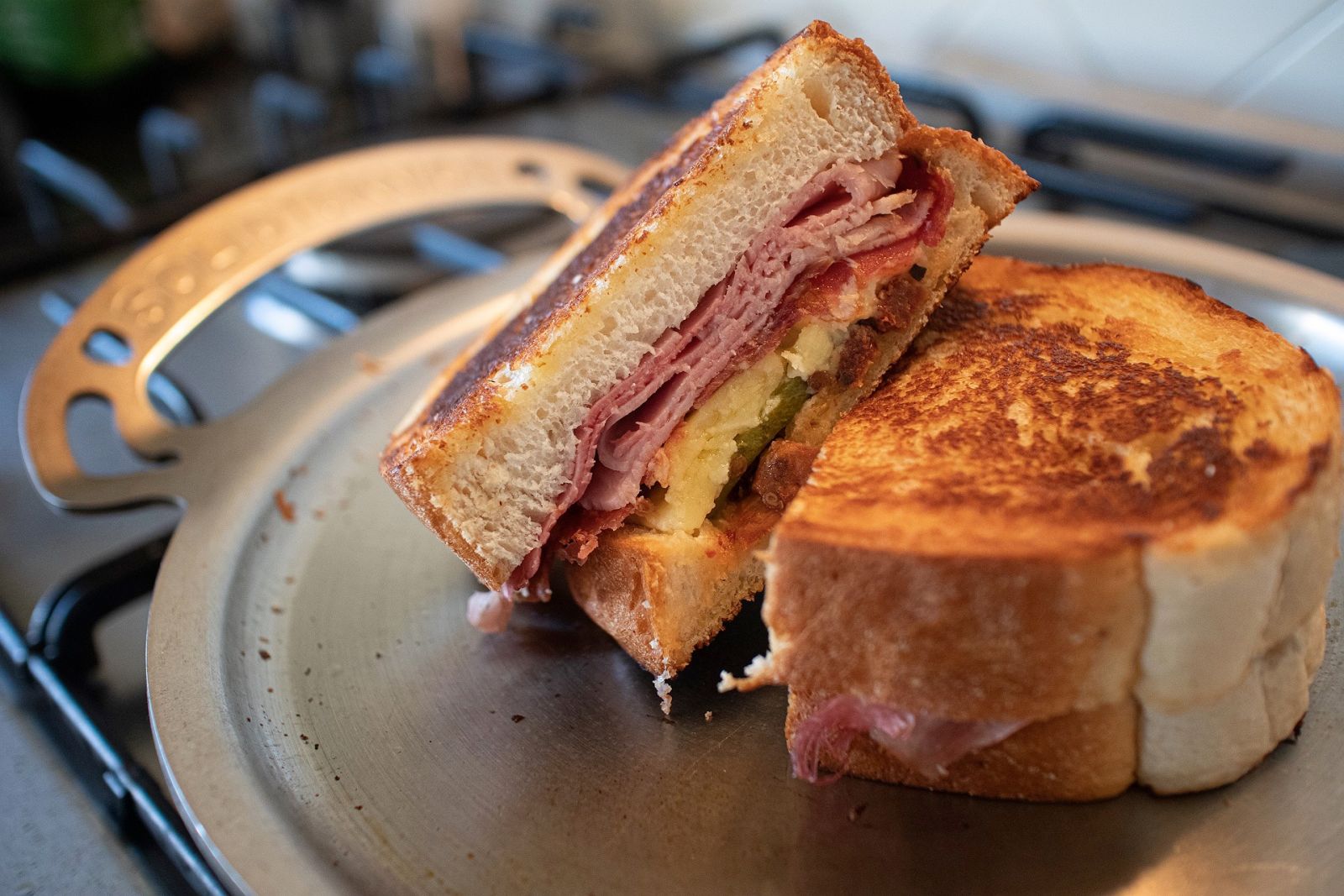
Cooking stir-fry in an iron wok can be a fun and delicious experience. Here's a step-by-step process on how to cook a basic stir-fry using one of our iron woks.
450g of your choice of protein (chicken, beef, tofu, etc.), thinly sliced or cubed
2-3 cups of mixed vegetables (capsicum, broccoli, carrots, snap peas, mushrooms, etc.), sliced or chopped
2-3 cloves of garlic, minced
1 piece of fresh ginger, minced or grated
2 tablespoons of oil
2-3 tablespoons of soy sauce
1 tablespoon of oyster sauce (optional)
1 teaspoon of cornflour (to thicken the sauce, optional)
Salt and pepper to taste
Chilli flakes or chilli sauce (optional, for some heat)
Cooked rice or noodles for serving.
Iron wok
TSS or kitchen tool for stirring
Cutting board and knife
Bowls for marinating and mixing sauces
Paper towels (for drying protein).
Prepare all your ingredients before you start cooking. This includes slicing the protein, chopping vegetables, mincing garlic and ginger, and measuring out sauces and spices.
If you're using meat, pat it dry with paper towels to remove excess moisture. This helps with achieving a nice sear.
If you want to marinate your protein for extra flavour, mix it with a tablespoon of soy sauce and a pinch of corn flour. Let it sit for about 15-20 minutes while you prepare other ingredients.
Place your wok on high heat and let it get smoking hot. This can take a few minutes, and the wok should start to change colour slightly.
Once the wok is hot, add the oil and swirl it around to coat the entire surface. (Be careful as it may splatter).
Add the minced garlic and ginger to the hot oil and stir-fry for about 15-20 seconds until fragrant.
Taste the stir-fry and adjust the seasoning with salt, pepper and chilli sauce (if desired).
Serve your stir-fry over cooked rice or noodles, and enjoy your delicious homemade meal!
(3).gif)
Remember that stir-frying is a quick-cooking method, so it's essential to have all your ingredients prepared and ready to go before you start cooking. Enjoy your iron wok stir-fry!

If you still haven't found what you’re looking for, please email us for one-on-one help from our awesome Solid customer care team: info@solidteknics.com
Remember: Seasoned iron is forever renewable. It's a marathon, not a sprint.
Copyright © 2025 SOLIDTEKNICS PTY LTD. All Rights Reserved
ABN: 17600300481. E-commerce software by Neto
In the spirit of reconciliation Solidteknics acknowledges the Traditional Custodians of country throughout Australia and their connections to land, sea and community. We pay our respect to their Elders past and present and extend that respect to all Aboriginal and Torres Strait Islander peoples today.